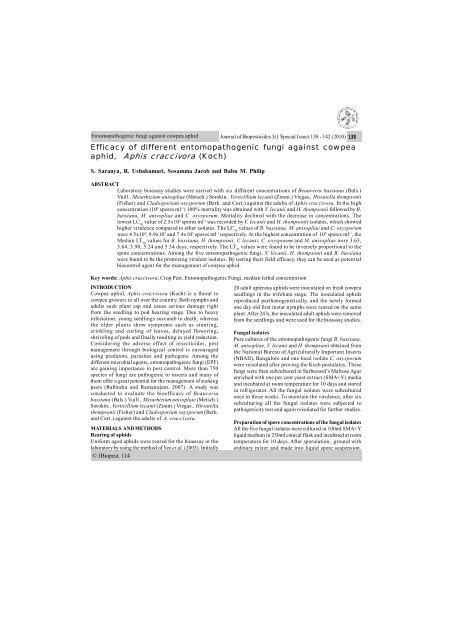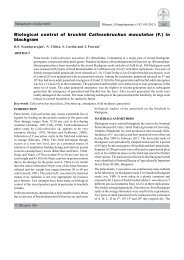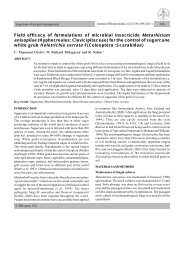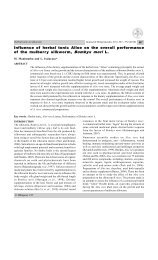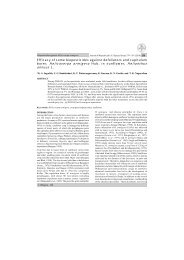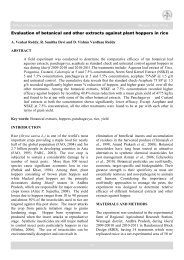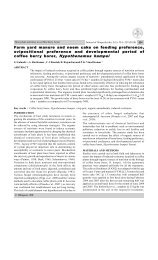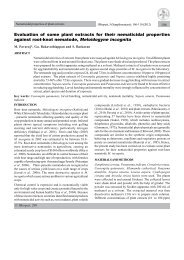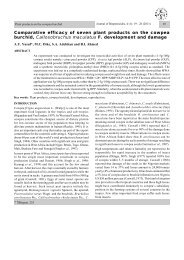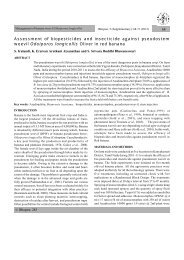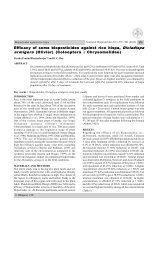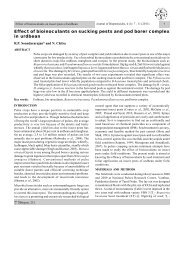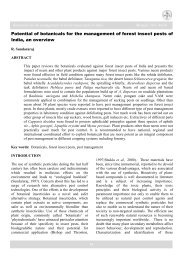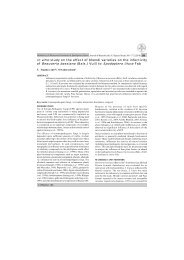aphid, Aphis craccivora (Koch) - Jbiopest.com
aphid, Aphis craccivora (Koch) - Jbiopest.com
aphid, Aphis craccivora (Koch) - Jbiopest.com
Create successful ePaper yourself
Turn your PDF publications into a flip-book with our unique Google optimized e-Paper software.
Entomopathogenic fungi against cowpea <strong>aphid</strong><br />
Journal of Biopesticides 3(1 Special Issue) 138 - 142 (2010) 138<br />
Efficacy of different entomopathogenic fungi against cowpea<br />
<strong>aphid</strong>, <strong>Aphis</strong> <strong>craccivora</strong> (<strong>Koch</strong>)<br />
S. Saranya, R. Ushakumari, Sosamma Jacob and Babu M. Philip<br />
ABSTRACT<br />
Laboratory bioassay studies were carried with six different concentrations of Beauveria bassiana (Bals.)<br />
Vuill., Metarhizium anisopliae (Metsch.) Sorokin., Verticillium lecanii (Zimm.) Viegas., Hirsutella thompsonii<br />
(Fisher) and Cladosporium oxysporum (Berk. and Curt.) against the adults of <strong>Aphis</strong> <strong>craccivora</strong>. In the high<br />
concentration (10 8 spores ml -1 ) 100% mortality was obtained with V. lecanii and H. thompsonii followed by B.<br />
bassiana, M. anisopliae and C. oxysporum. Mortality declined with the decrease in concentrations. The<br />
lowest LC 50<br />
value of 2.5x10 4 spores ml -1 was recorded by V. lecanii and H. thompsonii isolates, which showed<br />
higher virulence <strong>com</strong>pared to other isolates. The LC 50<br />
values of B. bassiana, M. anisopliae and C. oxysporum<br />
were 4.5x10 4 , 8.9x10 5 and 7.4x10 5 spores ml -1 respectively. At the highest concentration of 10 8 spores ml -1 , the<br />
Median LT 50<br />
values for B. bassiana, H. thompsonii, V. lecanii, C. oxysporum and M. anisopliae were 3.63,<br />
3.64, 3.90, 5.24 and 5.54 days, respectively. The LT 50<br />
values were found to be inversely proportional to the<br />
spore concentrations. Among the five entomopathogenic fungi, V. lecanii, H. thompsonii and B. bassiana<br />
were found to be the promising virulent isolates. By testing their field efficacy, they can be used as potential<br />
biocontrol agent for the management of cowpea <strong>aphid</strong>.<br />
Key words: <strong>Aphis</strong> <strong>craccivora</strong>, Crop Pest, Entomopathogenic Fungi, median lethal concentration<br />
INTRODUCTION<br />
Cowpea <strong>aphid</strong>, <strong>Aphis</strong> <strong>craccivora</strong> (<strong>Koch</strong>) is a threat to<br />
cowpea growers in all over the country. Both nymphs and<br />
adults suck plant sap and cause serious damage right<br />
from the seedling to pod bearing stage. Due to heavy<br />
infestation, young seedlings succumb to death, whereas<br />
the older plants show symptoms such as stunting,<br />
crinkling and curling of leaves, delayed flowering,<br />
shriveling of pods and finally resulting in yield reduction.<br />
Considering the adverse effect of insecticides, pest<br />
management through biological control is encouraged<br />
using predators, parasites and pathogens. Among the<br />
different microbial agents, entomopathogenic fungi (EPF)<br />
are gaining importance in pest control. More than 750<br />
species of fungi are pathogenic to insects and many of<br />
them offer a great potential for the management of sucking<br />
pests (Rabindra and Ramanujam, 2007). A study was<br />
conducted to evaluate the bioefficacy of Beauveria<br />
bassiana (Bals.) Vuill., Metarhizium anisopliae (Metsch.)<br />
Sorokin., Verticillium lecanii (Zimm.) Viegas., Hirsutella<br />
thompsonii (Fisher) and Cladosporium oxysporum (Berk.<br />
and Curt.) against the adults of A. <strong>craccivora</strong>.<br />
MATERIALS AND METHODS<br />
Rearing of <strong>aphid</strong>s<br />
Uniform aged <strong>aphid</strong>s were reared for the bioassay in the<br />
laboratory by using the method of Yeo et al. (2003). Initially<br />
© JBiopest. 114<br />
20 adult apterous <strong>aphid</strong>s were inoculated on fresh cowpea<br />
seedlings in the trifoliate stage. The inoculated <strong>aphid</strong>s<br />
reproduced parthenogenetically, and the newly formed<br />
one day old first instar nymphs were reared on the same<br />
plant. After 24 h, the inoculated adult <strong>aphid</strong>s were removed<br />
from the seedlings and were used for the bioassay studies.<br />
Fungal isolates<br />
Pure cultures of the entomopathogenic fungi B. bassiana,<br />
M. anisopliae, V. lecanii and H. thompsonii obtained from<br />
the National Bureau of Agriculturally Important Insects<br />
(NBAII), Bangalore and one local isolate C. oxysporum<br />
were reisolated after proving the <strong>Koch</strong> postulates. These<br />
fungi were then subcultured in Sarbaourd’s Maltose Agar<br />
enriched with one per cent yeast extract (SMA+Y) media<br />
and incubated at room temperature for 10 days and stored<br />
in refrigerator. All the fungal isolates were subcultured<br />
once in three weeks. To maintain the virulence, after six<br />
subculturing all the fungal isolates were subjected to<br />
pathogenicity test and again reisolated for further studies.<br />
Preparation of spore concentrations of the fungal isolates<br />
All the five fungal isolates were cultured in 100ml SMA+Y<br />
liquid medium in 250ml conical flask and incubated at room<br />
temperature for 10 days. After sporulation, ground with<br />
ordinary mixer and made into liquid spore suspension.
S. Saranya et al.<br />
This was filtered through double layered muslin cloth to<br />
remove the mycelial mat. The suspension was shaken<br />
thoroughly with a drop of Teepol solution for uniform<br />
dispersion of the spores in the solution. The spore count<br />
was made by using a haemocytometer. All the cultures<br />
were adjusted to 1x 10 8 spores ml -1 from which the lower<br />
concentrations were prepared by serial dilution technique<br />
for bioassay studies.<br />
Bioassay<br />
Cowpea seedlings were raised in small paper cups of size<br />
7.5x7.5cm in the laboratory. Fifteen days old seedlings<br />
were used for the bioassay studies. Six different spore<br />
concentrations (1x10 8 , 1x10 7 , 1x10 6 , 1x10 5 , 1x10 4 , 1x10 3<br />
spores ml -1 ) were prepared for B. bassiana, M. anisopliae,<br />
V. lecanii, H. thompsonii and the local isolate C.<br />
oxysporum. Each concentration was replicated three times.<br />
One day old adult apterous <strong>aphid</strong>s were inoculated on<br />
the cowpea seedlings using a camel hairbrush @ 10 <strong>aphid</strong>s<br />
per seedling. Totally 30 <strong>aphid</strong>s were used for each<br />
treatment. After inoculation of <strong>aphid</strong>s, the respective<br />
concentrations of all the fungal spore suspensions were<br />
sprayed on the seedlings using an atomizer. Aphids<br />
sprayed with 0.05 per cent Teepol solution served as<br />
control. After spraying, seedlings were kept under belljar<br />
to avoid the escape of <strong>aphid</strong> population and to maintain<br />
the humidity. The mouth of the cup was closed with white<br />
paper, for the easy collection of dead <strong>aphid</strong>s<br />
Mortality of <strong>aphid</strong>s was recorded separately at 24 h<br />
interval up to seven days. Dead <strong>aphid</strong>s were collected<br />
daily, and placed in Petridish containing a moist filter paper<br />
and kept in humid chamber. The dead <strong>aphid</strong>s which<br />
produced mycelial growth were considered for the<br />
mortality count. Neonate <strong>aphid</strong>s were counted and<br />
removed daily from the seedlings. Mortality data was<br />
corrected with that in control by using the Abbott’s<br />
formula (Abbott, 1925). The data was then analysed by<br />
probit analysis (Finney, 1971) and the Median Lethal<br />
Concentration (LC 50<br />
) and the Median Lethal Time (LT 50<br />
)<br />
values were <strong>com</strong>puted by using statistical <strong>com</strong>puter<br />
programme, Statistical Package of Social Sciences (SPSS).<br />
Statistical analysis<br />
The per cent corrected cumulative mortality of each<br />
fungus was subjected to ANOVA test and the means were<br />
separated by Duncan’s Multiple Range Test (DMRT).<br />
RESULTS AND DISCUSSION<br />
Mortality of adults of A. <strong>craccivora</strong><br />
Mortality of <strong>aphid</strong>s was monitored at 24 h interval upto<br />
seven days. The data of corrected per cent mortality at<br />
139<br />
different time intervals presented in Table 1 indicates that<br />
the mortality increased with increase in time interval.<br />
Mortality of <strong>aphid</strong>s was 3.33 per cent observed with in 24<br />
h, at the highest concentration (10 8 spores ml -1 ) of B.<br />
bassiana, V. lecanii and H. thompsonii. After 48 h of<br />
exposure, among the five fungal isolates B. bassiana, H.<br />
thompsonii and C. oxysporum recorded of per cent<br />
mortality ranging between 3.33 to 13.33 at 10 8 and<br />
10 7 spores ml -1 and 3.33 to 6.66 per cent at 10 6 spores ml -1 .<br />
All the concentrations of B. bassiana and C. oxysporum<br />
recorded mortality of <strong>aphid</strong>s after 72 h only; mortality in<br />
different concentrations ranged between 6.66 to 43.33 and<br />
6.66 to 20.00 per cent in B. bassiana and C. oxysporum<br />
respectively. However, mortality was recorded in other<br />
fungal isolates namely M. anisopliae, V. lecanii and H.<br />
thompsonii at the highest concentration (10 8 spores ml -1 )<br />
only; they produced 6.66 to 35.71 per cent mortality.<br />
At 120 h (5 days) after treatment the highest per cent<br />
mortality was obtained in the highest spore concentration<br />
of 10 8 spores ml -1 in V. lecanii (88.46%) followed by H.<br />
thompsonii (80.70%) and B. bassiana (73.33%).<br />
Cladosporium oxysporum and M. anisopliae resulted in<br />
lower mortality of 46.43 and 42.86 per cent respectively.<br />
At 10 7 spores ml -1 , B. bassiana and V. lecanii obtained<br />
more than 50 per cent mortality 66.66 and 76.96 per cent<br />
respectively. Hirsutella thompsonii, HhhhhM. anisopliae<br />
and C. oxysporum recorded the least mortality ranging<br />
between 3.33 to 10.34 per cent at the least concentration<br />
10 3 spores ml -1 . At 144 h (6 days) and 168 h (7 days) after<br />
treatment there was marked increase in the mortality of<br />
<strong>aphid</strong>s. Among the five isolates, V. lecanii at 10 8 spores<br />
ml -1 showed cent per cent mortality on the 6 th day followed<br />
by H. thompsonii (96.50%).<br />
All the fungal isolates in the highest spore concentration<br />
(10 8 spores ml -1 ) produced high mortality ranging from<br />
77.50 to 100 per cent, after seven days of treatment. Among<br />
the five isolates V. lecanii and H. thompsonii gave cent<br />
per cent mortality. Yokomi and Gottwald (1988) also<br />
reported cent per cent mortality of three <strong>aphid</strong> species<br />
Myzus persicae, <strong>Aphis</strong> gossypii and <strong>Aphis</strong> citricola at<br />
10 6 -10 7 spores ml -1 after four days. Increased mortality of<br />
H. thompsonii at 10 8 spores ml -1 has also been reported<br />
by Smitha (2007); she obtained 90 per cent mortality of<br />
banana mealy bug, Geococcus sp. after three days of<br />
inoculation.<br />
At the highest concentration of 10 8 spores ml -1 , B. bassiana<br />
and M. anisopliae also gave appreciable reduction in<br />
population showing 96.66 and 80.76 per cent respectively.<br />
Ekesi et al. (2000) also got similar result with 91 and 93 per<br />
cent mortality of A. <strong>craccivora</strong> at 7 th day of treatment.
Entomopathogenic fungi against cowpea <strong>aphid</strong><br />
140<br />
Table 1. Effect of fungal isolates on the mortality of adults of A. <strong>craccivora</strong> at different time interval<br />
Corrected mortality (%)<br />
Fungal Isolate Dose(spores/ml)<br />
Hours<br />
24 48 72 96 120 144 168<br />
B. bassiana 10 8 3.33 10.00 26.66 43.33 73.33 86.66 96.66<br />
10 7 0.00 6.66 43.33 60.00 66.66 76.66 83.33<br />
10 6 0.00 6.66 33.33 40.00 53.33 66.67 70.00<br />
10 5 0.00 0.00 20.00 33.33 40.00 43.33 50.00<br />
10 4 0.00 0.00 6.66 20.00 33.33 36.66 40.00<br />
10 3 0.00 0.00 6.66 10.00 23.33 26.66 26.66<br />
M. anisopliae. 10 8 0.00 0.00 6.66 24.14 42.86 51.85 80.76<br />
10 7 0.00 0.00 6.66 13.79 17.86 33.33 61.53<br />
10 6 0.00 0.00 3.33 3.33 13.79 29.62 50.00<br />
10 5 0.00 0.00 3.33 6.89 10.34 29.62 38.47<br />
10 4 0.00 0.00 0.00 10.34 17.24 18.51 23.07<br />
10 3 0.00 0.00 0.00 3.33 6.89 14.14 19.23<br />
V. lecanii 10 8 3.33 3.33 17.86 53.84 88.46 100.00 100.00<br />
10 7 0.00 0.00 32.14 50.00 76.96 92.30 100.00<br />
10 6 0.00 0.00 17.86 42.30 50.00 76.92 84.00<br />
10 5 0.00 0.00 21.43 32.14 46.15 57.69 60.00<br />
10 4 0.00 0.00 7.14 15.39 23.07 34.61 44.00<br />
10 3 0.00 0.00 0.00 11.54 23.07 26.92 28.00<br />
H. thompsonii 10 8 3.33 13.33 35.71 60.71 80.70 96.50 100.00<br />
10 7 0.00 13.33 28.57 39.29 46.18 76.91 96.00<br />
10 6 0.00 3.33 7.14 21.43 26.94 61.53 80.00<br />
10 5 0.00 0.00 10.72 26.94 28.57 57.69 60.00<br />
10 4 0.00 0.00 7.14 14.29 23.07 42.30 44.00<br />
10 3 0.00 0.00 0.00 3.33 3.33 7.69 20.00<br />
C. oxysporum 10 8 0.00 6.66 20.00 24.14 46.43 64.28 77.50<br />
10 7 0.00 3.33 16.66 13.79 37.93 57.13 60.71<br />
10 6 0.00 3.33 13.33 13.79 31.03 39.29 49.99<br />
10 5 0.00 3.33 10.00 10.34 27.58 35.71 39.29<br />
10 4 0.00 0.00 6.66 13.79 24.14 25.00 28.57<br />
10 3 0.00 0.00 6.66 3.45 10.34 14.29 17.86<br />
Loureiro and Moino (2006) recorded 100 % mortality of<br />
Myzus persicae with B. bassiana and M. anisopliae applied<br />
at 10 6 and 10 7 spores ml -1 , respectively. The local isolate, C.<br />
oxysporum recorded 77.57 per cent mortality with 10 8 spores<br />
ml -1 . Ramegowda et al. (2007) had reported 93.33 per cent<br />
mortality in C. lanigera, ten days after treatment. A<br />
progressive reduction in the mortality of <strong>aphid</strong>s was<br />
observed with decreasing concentrations. In the lower<br />
concentration, 10 3 spores ml -1 the mortality of <strong>aphid</strong>s ranged<br />
between 17.86 to 28.00 per cent. At in adequate spore<br />
concentration the time taken for multiplication may be<br />
prolonged resulting in a reduced control of the <strong>aphid</strong>s.<br />
Cumulative mortality of A. <strong>craccivora</strong><br />
The corrected cumulative mortality per cent at seven days<br />
after treatment was analysed by ANOVA and the results<br />
are presented in Table 2. The cumulative per cent mortality<br />
of A. <strong>craccivora</strong> with the fungal isolates was found to be<br />
statistically on a par at 10 8 concentration. At the highest<br />
concentration of 10 8 spores ml -1 , V. lecanii and H.<br />
thompsonii produced cent per cent mortality and was found<br />
to be equal to other fungal isolates. It was closely followed<br />
by B. bassiana causing 96.66 per cent mortality which was<br />
as effective as V. lecanii and H. thompsonii. In the next<br />
lower concentration also, V. lecanii produced cent per cent<br />
cumulative mortality of <strong>aphid</strong>s. Hirsutella thompsonii and<br />
B. bassiana were found to be on a par with V. lecanii<br />
producing 96.00 and 83.33 per cent mortality respectively.<br />
Median Lethal Concentration (LC 50<br />
)<br />
The data presented in Table 3 shows the LC 50<br />
values and<br />
the relative toxicity of the five fungal isolates. Among the
S. Saranya et al.<br />
141<br />
Table 2. Dose mortality response of fungal isolates against A. <strong>craccivora</strong><br />
Fungal isolate<br />
Heterogenety Regression equation LC 50<br />
(spores 95% Fiduciallimits Relative<br />
(χ2) ml -1 ) (spores ml -1 ) toxicity<br />
B. bassiana 4.724 Y = 2.0507+0.44× 4.5×10 4 1.1×10 4 - 3.4×10 5 1.8<br />
M. anisopliae 4.303 Y = 2.7301+0.62× 8.9×10 5 4.1×10 5 - 1.8×10 7 35.6<br />
V. lecanii 4.303 Y = -2.7308+4.3× 2.5×10 4 1.5×10 4 - 4.0×10 4 1.0<br />
H. thompsonii 3.681 Y = -2.025+0.34× 2.5×10 4 1.5×10 4 - 4.0×10 4 1.0<br />
C. oxysporum 1.277 Y = -1.891+0.32× 7.4×10 5 2.6×10 5 - 1.6×10 6 29.6<br />
five fungal isolates, V. lecanii and H. thompsonii caused<br />
50 per cent mortality at the lowest concentration of 2.5<br />
x10 4 spores ml -1 . This was followed by B. bassiana (4.5x10 5<br />
spores ml -1 ), C. oxysporum (7.4x10 5 spores ml -1 ) and M.<br />
anisopliae (8.9x10 5 spores ml -1 ). It is understood that<br />
higher the LC 50<br />
values, higher will be the relative toxicity .<br />
Low LC 50<br />
value of 1.2x10 4 spores ml -1 for V. lecanii against<br />
Brevicoryne brassicae and 2.7x10 4 spores ml -1 against<br />
<strong>Aphis</strong> gossypii was reported by Derakshan et al. (2007)<br />
and Karindah et al. (1996) respectively is in conformity<br />
with the present finding. LC 50<br />
value obtained in the present<br />
study was lower than that reported by Smitha (2007) for<br />
Hirsutella sp (5.2x10 4 spores ml -1 ), but higher than reported<br />
by Liu et al. (1999) for B. bassiana (1.2x10 4 spores ml -1 )<br />
and Chandler (1997) for M. anisopliae (2.45x10 6 spores<br />
ml -1 ). The difference in the LC 50<br />
values might be due to<br />
the difference in the virulence of fungal isolates and the<br />
host species. Among the five fungal isolates, V. lecanii<br />
and H. thompsonii were the most virulent isolates with<br />
the lowest LC 50<br />
and relative toxicity. This was followed<br />
by B. bassiana with a relative toxicity value of 1.8.<br />
Metarhizium anisopliae and C. oxysporum recorded<br />
higher LC 50<br />
and relative toxicity values. Both these isolates<br />
less virulent <strong>com</strong>pared to other isolates.<br />
Median Lethal Time (LT 50<br />
)<br />
Variation in LT 50<br />
values at different concentrations was<br />
evident (Table 4). LT 50<br />
values decreased with increase in<br />
concentrations. At 10 8 spores ml -1 , low LT 50<br />
value was<br />
recorded by B. bassiana, H. thompsonii and V. lecanii as<br />
3.63, 3.64 and 3.90 days respectively. Nirmala et al. (2006)<br />
also attained similar results for B. bassiana with LT 50<br />
value<br />
Table 3. Time mortality response of fungal isolates<br />
against A. <strong>craccivora</strong><br />
Fungal isolate Median Lethal Time (Days)<br />
10 8 10 7 10 6 10 5 10 4 10 3<br />
B.bassiana 3.63 4.51 5.83 5.98 6.88 8.11<br />
M.anisopliae 5.54 6.61 7.01 7.43 8.65 8.91<br />
V.lecanii 3.90 3.96 4.86 5.65 7.25 7.87<br />
H.thompsonii 3.64 4.52 5.84 5.98 6.89 8.12<br />
C.oxysporum 5.24 5.96 6.75 7.34 8.19 10.17<br />
of 3.17 days. The LT 50<br />
value of 3.31 days has been obtained<br />
for V. lecanii against <strong>Aphis</strong> fabae by Hesketh et al. (2008)<br />
also agree with the present finding. Metarhizium anisopliae<br />
and C. oxysporum recorded higher LT 50<br />
values of 5.54 and<br />
5.24 respectively at 10 8 spores ml -1 . Under laboratory<br />
conditions, V. lecanii and H. thompsonii were found to be<br />
more virulent recording cent per cent mortality within seven<br />
days after treatment. Other fungal isolates also showed<br />
promising result. The lowest LC 50<br />
and LT 50<br />
values of V. lecanii,<br />
H. thompsonii and B.bassiana indicate its higher virulence<br />
against A.<strong>craccivora</strong>. they can be used as potential<br />
biocontrol agent after field experiments for the management<br />
of cowpea <strong>aphid</strong>.<br />
REFERENCES<br />
Abbott, W. S. 1925. A method of <strong>com</strong>puting the<br />
effectiveness of an insecticide. Journal of Economic<br />
Entomology, 18: 265-267.<br />
Chandler, D. 1997. Selection of an isolate of the insect<br />
pathogenic fungus Metarhizium anisopliae virulent<br />
to the lettuce root <strong>aphid</strong>, Pemphigus bursarius.<br />
Biocontrol Science and Technology, 7: 95-104<br />
Derakshan, A., Rabindra, R. J. and Ramunujam, B. 2007.<br />
Efficacy of different isolates of entomopathogenic<br />
fungi against Brevicoryne brassicae (Linnaeus) at<br />
different temperature and humidities. Journal of<br />
Biological Control, 21(1): 65-72.<br />
Ekesi, S., Akpa, A. D., Onu, I. and Ogunlana, M. O. 2000.<br />
Entomopathogenicity of Beauveria bassiana and<br />
Metarhizium anisopliae to the cowpea <strong>aphid</strong>, <strong>Aphis</strong><br />
<strong>craccivora</strong> <strong>Koch</strong> (Homoptera: Aphididae). Archives of<br />
Phytopathology and Plant Protection, 33(2): 171-180.<br />
Finney, D. J. 1971. Probit Analysis, 3 rd edition. Cambridge<br />
university Press, 333 P.<br />
Hesketh, H., Alderson, P. G., Pye, B. J. and Pell, J. K. 2008.<br />
The development and multiple uses of a standardised<br />
bioassay method to select hypocelerean fungi from<br />
biological control of <strong>aphid</strong>s. Biological Control, 26(2):<br />
242-255.<br />
Karindah, S., Rahardjo, B. T. and Santoso, S. 1996.<br />
Virulence of the fungus Verticillium lecanii Zimmer<br />
mann against <strong>Aphis</strong> gossypii Glover (Homoptera:<br />
Aphididae). Agrivita, 19(1): 30-34.
Entomopathogenic fungi against cowpea <strong>aphid</strong><br />
Koshy, G., Nandakumar, C. and Premila, K. S. 1987. Need<br />
based use of insecticides for the control of pests of<br />
cowpea in rice fallows of Kerala. Journal of Tropical<br />
Agriculture, 7(1): 25-27.<br />
Liu, Y. Q., Liu, S. S. and Feng, M. G. 1999. Effect of<br />
Beauveria bassiana on the fecundity of the green<br />
peach <strong>aphid</strong>, Myzus persicae. Acta Phytophylacica<br />
Sinica, 26(1): 30-34.<br />
Loureiro, E. D. S. and Moino, J. A., 2006. Pathogenicity of<br />
hyphomycete fungi to <strong>aphid</strong>s <strong>Aphis</strong> gossypii Glover<br />
and Myzus persicae (Sulzer) (Hemiptera: Aphididae).<br />
Neotropical Entomology, 35(5): 660-665.<br />
Nirmala, R., Ramanujam, B., Rabindra, R. J. and Rao, N. S.<br />
2006. Effect of entomofungal pathogens on mortality<br />
of three <strong>aphid</strong> species. Journal of Biological Control,<br />
20(1): 89-94.<br />
Rabindra, R. J. and Ramanujam, B., 2007. Microbial control<br />
of sucking pests using entomopathogenic fungi.<br />
Journal of Biological Control, 21(Special): 21-28.<br />
Ramegowda, G. K., Vidya, M., Patil, R. K., Puttannavar, M.<br />
S. and Lingappa, S. 2007. Laboratory and field<br />
evaluation of some entomopathogenic fungi against<br />
142<br />
sugarcane woolly <strong>aphid</strong>, Ceratovacuna lanigera<br />
Zehntner (Homoptera: Aphididae). Journal of<br />
Biological Control, 21(Special): 173-176.<br />
Smitha, 2007. Biology and management of root mealy bug<br />
on banana cultivars. Ph.D Thesis, Kerala Agricultural<br />
University, Thrissur 135 PP.<br />
Yeo, H., Pell, J. K., Alderson, P. G., Clark, S. J. and Pye, B.<br />
J. 2003. Laboratory evaluation of temperature effects<br />
on the germination and growth of entomopathogenic<br />
fungi and on their pathogenicity to two <strong>aphid</strong> species.<br />
Pest Managment Science, 59(2): 156-165.<br />
Yokomi, R. K. and Gottwald, T. R. 1988. Virulence of<br />
Verticillium lecanii isolates in <strong>aphid</strong>s determined by<br />
bioassay. Journal of Invertebrate Pathology, 51: 250–<br />
258.<br />
___________________________________________<br />
S. Saranya*, R. Ushakumari, Sosamma Jacob. and Babu<br />
M. Philip.<br />
Department of Agricultural Entomology, College of<br />
Horticulture, Kerala Agricultural University,Vellanikkara,<br />
Thrissur-680656, Kerala, *E- mail: saransellamuthu<br />
@gmail.<strong>com</strong>


